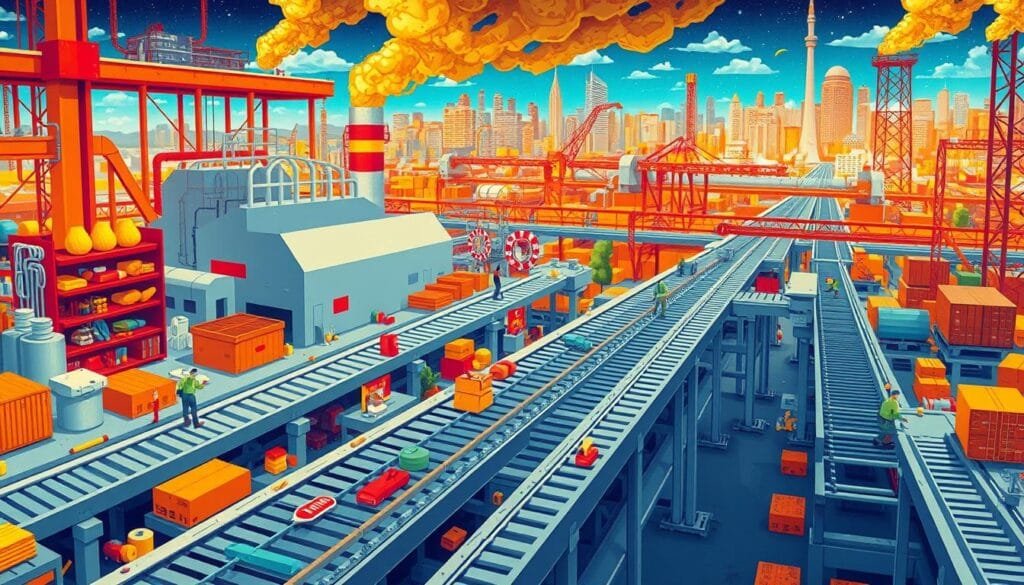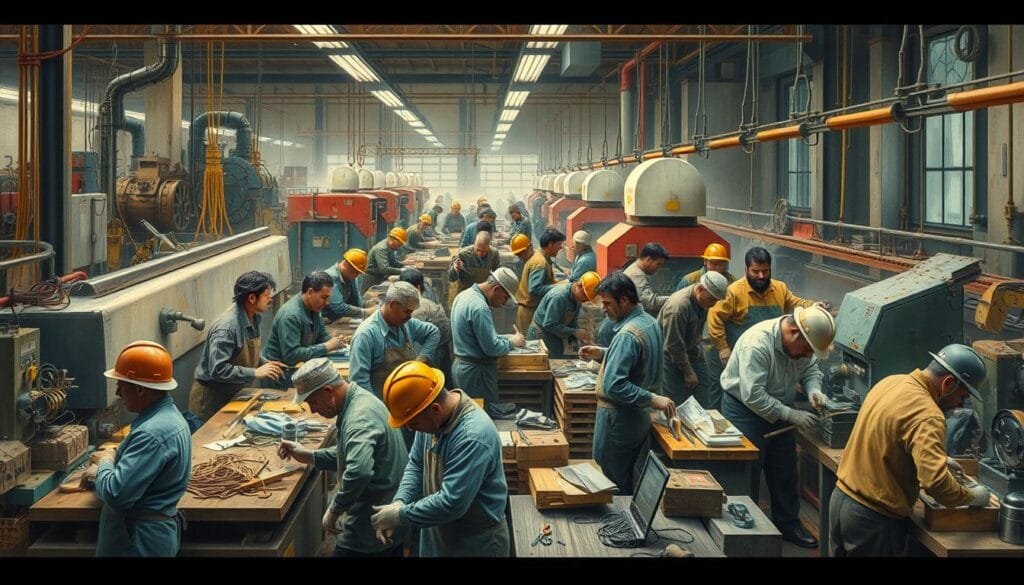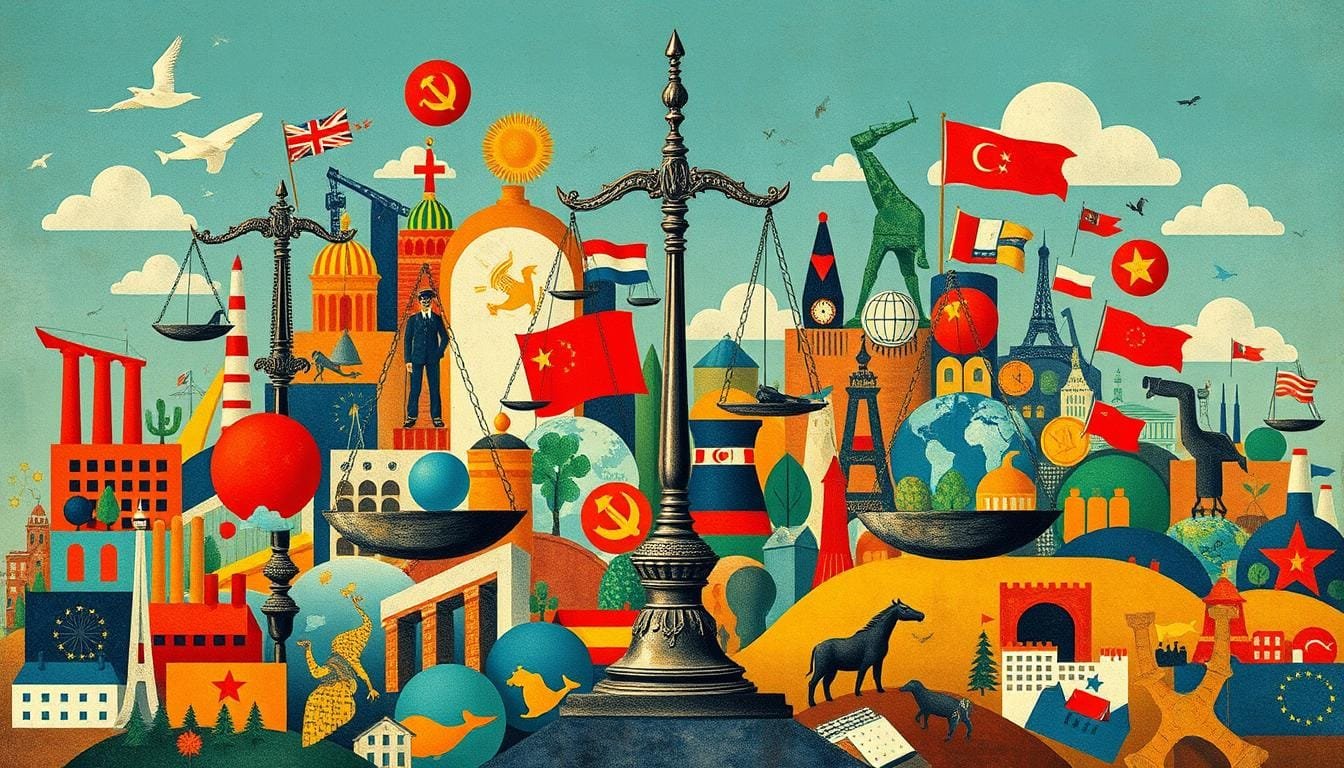How do different economic systems shape societies by managing resources? This is what we’ll explore together.
We will look into the resource mix within economics. We’ll see how systems like capitalism, socialism, and the mixed economic system handle resources such as labor, capital, and land. This is vital for understanding market dynamics and economic planning.
Most economies today, from Western Europe’s past to East Asia’s modern strategies, are mixed economies. These blend market and command economy features.
These mixed economies see governments stepping in to help balance resource allocation. They might use trade protection, subsidies, or tax credits. For instance, the US government offers social benefits and supports certain industries to encourage innovation and efficiency.
Yet, this balance can lead to issues. For one, government and market forces might cause regulatory capture. Also, extensive social programs can raise concerns over the tax burden. Some critics, like the Public Choice school, believe too much government intervention can hurt the economy.
At its heart, mixed economic systems involve government and market work together. This plays a critical role in forming business strategies and policies worldwide.
Key Takeaways
- Mixed economies mix market and command economy elements.
- Governments use tools like subsidies and tax credits for resource allocation.
- They aim to maintain fair market dynamics through regulations.
- Government actions can lead to concerns about taxes and regulatory capture.
- Grasping the nuances of different economic systems helps in sound economic planning and strategy.
What is a Mixed Economic System?
A mixed economic system combines aspects of both capitalism and socialism. It aims to find a middle ground between private business and government control. This approach has shown its ability to adapt and be resilient, bringing together different economic ideas.
Definition and Features
In a mixed economic system, private and public sectors exist together. It joins the efficiency of private companies with the welfare goals of the government. This mix tries to improve economic welfare and meet social aims.
The government plays a key role, especially when it needs to fix market failures. It uses taxes, subsidies, and rules for this.
Mixed Economy vs. Free Markets
Mixed economies differ from free markets by handling market failures and aiming for societal welfare. In free markets, resource allocation is mainly by market forces with little government role. But mixed economies use government actions to adjust resources when needed.
This balance helps prevent monopolies and encourages fair competition. It leads to a more equal resource sharing.
Mixed Economy vs. Socialism
Mixed economies and socialism have different ways of managing the economy. Socialism has more state ownership to lessen capitalism’s inequalities. Mixed economies let private ownership exist but with regulation and intervention in crucial areas.
This keeps motivation for private businesses while making sure key services are reachable and affordable. In Western Europe, public ownership is between 15% to 20%, showing the aim for fair resource sharing and encouraging private sector growth.
| Feature | Mixed Economy | Free Market | Socialism |
|---|---|---|---|
| Private Ownership | Yes | Yes | No, limited to none |
| Government Intervention | Moderate | Minimal | Extensive |
| Economic Goals | Efficiency & Equity | Efficiency | Equity |
| Examples of Systems | Modern China, Russia | U.S. during early capitalism | Soviet Union |
Looking at capitalism vs socialism through mixed economies shows the importance of balancing private action and public interest. This balance has been part of economic systems from Ancient Greek city-states to today’s China and Russia. It shows how mixed economic systems have always been relevant and adaptable.
What is a Resource Mix in Economics
A resource mix in economics combines inputs like labor, capital, and technology. These inputs create goods and services. The right mix improves efficiency and productivity. It also helps a firm stand out and boosts a nation’s economy. Different factors, such as tech, money, skills, and policies, affect resource allocation in sectors.

Planning resources wisely is key for both businesses and governments. Mixed economies use a mix of market and command economy elements. They feature both private companies and government-run entities managing resources.
Mixed economies are found in places like the U.S., Canada, France, India, Brazil, and Australia. They foster innovation and care for the community. They aim to support everyone’s basic needs. Private and public sectors work together to use industry resources well.
Mixed economies tackle income inequality through policies like welfare and social security. These measures are funded by taxes. Countries like Iceland, Sweden, and France spend a lot on such programs. This shows their commitment to managing their economies well.
Let’s look at government spending as a percentage of GDP in various mixed economy countries:
| Country | Government Spending (% of GDP) |
|---|---|
| Iceland | 57% |
| Sweden | 52% |
| France | 52.8% |
| United Kingdom | 47.3% |
| United States | 38.9% |
| Russia | 34.1% |
| India | 27% |
| China | 20% |
| Hong Kong | 18.6% |
The resource mix in economics is crucial for mixed economies. It helps balance the private and public sectors. This balance promotes effective use of resources. Countries focus on strategic planning for a strong economy and well-being. More on this can be found here.
Internal vs. External Economies of Scale
Understanding internal and external economies of scale is key for businesses looking to grow. These economies of scale lead to cost benefits as companies produce more. This helps in making better strategies for growing the business and managing costs.

Internal Economies of Scale
Internal economies of scale happen when a company gets bigger. As it grows, the average cost per item can drop significantly. This happens through many different ways such as:
- Technical economies: Using big machinery in things like assembly lines cuts down costs.
- Bulk purchasing: Buying a lot at once to get a cheaper price per unit.
- Managerial efficiencies: Having skilled managers can make things run smoother and cheaper.
- Advertising economies: It’s cheaper to market more items at once.
- Network effects: More network use can reduce costs with better connections.
These advantages help companies beat their rivals because they can reduce costs in ways others can’t. For example, making more products can lower the cost for each one, but only up to a point. It’s important to avoid growing too fast, as this can lead to increased costs.
External Economies of Scale
External economies of scale benefit an entire industry, not just one company. They come from things like:
- Technological advancements: New tech can make the whole industry more efficient.
- Industry concentration: Lots of firms close together can share skilled workers and resources.
- Infrastructure developments: Better roads and networks lower shipping costs for everyone.
- Government incentives: Tax breaks or subsidies can help an entire industry.
These benefits are impactful because they help all companies in the industry. For example, Taiwan’s shared resources in semiconductors and the large pool of talent in Hollywood show how external economies of scale work. These shared benefits lower costs for making products and can keep new competitors out, which influences how companies compete with each other.
Implications of Labor and Capital Intensity
The balance between labor and capital shapes industries. It affects how we use our workforce and assets. Understanding the mix between labor-intensive and capital-intensive strategies is key.
Labor Intensive
Labor-intensive sectors depend more on people than machines. Industries like hospitality and handicrafts are examples. They need less money to start but pay more in wages later.
These sectors create lots of jobs and help local economies grow. Yet, they’re hit harder by changes in labor costs and availability.
Capital Intensive
Capital-intensive industries, like oil refining and car making, put more money into equipment. This means higher startup costs but could lead to lower costs later. Advances in technology make these industries more efficient.
From 1987 to 2013, more than 40 percent of output growth came from capital services. But, a drop in capital intensity also slowed economic growth by 0.41 percent a year.

Choosing labor or capital intensity involves many factors, like technology and labor costs. Each choice has pros and cons. It’s vital for future growth and efficiency to understand these factors.
Conclusion
Understanding how economic systems and resources work gives us key insights. It helps us see how societies and businesses make important decisions. Knowing the differences between various economies is essential for good economic analysis and resource planning. Each type has its pros and cons, often shaped by government roles and market freedom.
Mixed economies, common in developed nations, combine private and public sectors. They aim to balance market efficiency with social welfare. Achieving this balance can be hard, but it enhances freedom and choice. It also affects prices through supply and demand. The United Kingdom is an example of how mixed economies can encourage growth, especially in services that boost its GDP. Learn more by reading Economic Online’s definition of mixed economy.
From industries based on work and resources to growth benefits, our understanding helps us plan better in business. Leaders and economists must adapt to promote market efficiency and growth. This knowledge leads to smart decisions and supports sustainable growth in our fast-changing world.
FAQ
What is an economic system?
An economic system is how a society handles making, sharing, and using goods and services. There are types like capitalist, socialist, and mixed economies. They each use different ways to manage resources and plan the economy.
What are the key features of a mixed economic system?
A mixed economic system takes ideas from both capitalism and socialism. Private business ownership is allowed. However, the government steps in crucial areas. They use taxes, subsidies, and rules to support social welfare and fix market problems.
How does a mixed economic system differ from free markets?
In a mixed economy, the government plays a big role. This is unlike free markets which have little government touch. The aim is to fix market failures and ensure fair distribution of resources. The government enforces rules and offers public goods and services.
What separates a mixed economic system from socialism?
Socialism often means the government owns big industries. Mixed economy still has private ownership. But it also has strong regulation and government action. This helps fix market flaws and meet social goals.
What does resource mix mean in economics?
Resource mix talks about how labor, capital, and technology are used together to make goods and services. It’s key for getting the best efficiency, productivity, and economic health. The mix changes by sector due to new technologies and policies.
What are internal economies of scale?
Internal economies of scale are when a company saves money as it makes more products. Saving on bulk buys, getting better at operations, and using specialized workers. This makes the cost per product go down.
What are external economies of scale?
External economies of scale happen not just in one company, but across an industry or place. It’s often because firms are close by, share suppliers, and benefit from better infrastructure. These things lower costs for all firms in that industry.
What are labor-intensive industries?
Labor-intensive industries need a lot of human work. This is common in places like hotels and craft making. These industries may spend less on equipment but more on paying and managing people.
What characterizes capital-intensive industries?
Capital-intensive industries put a lot of money into machines and tech. This means high start-up costs but could lead to lower costs over time. Oil refining and car making are examples, where being efficient and big matters for doing well.
How do economies of scale influence business strategy?
Economies of scale shape business strategy by helping companies reduce costs and be more competitive. Internal economies make operations better, while external ones bring advantages through shared resources and better infrastructure.
